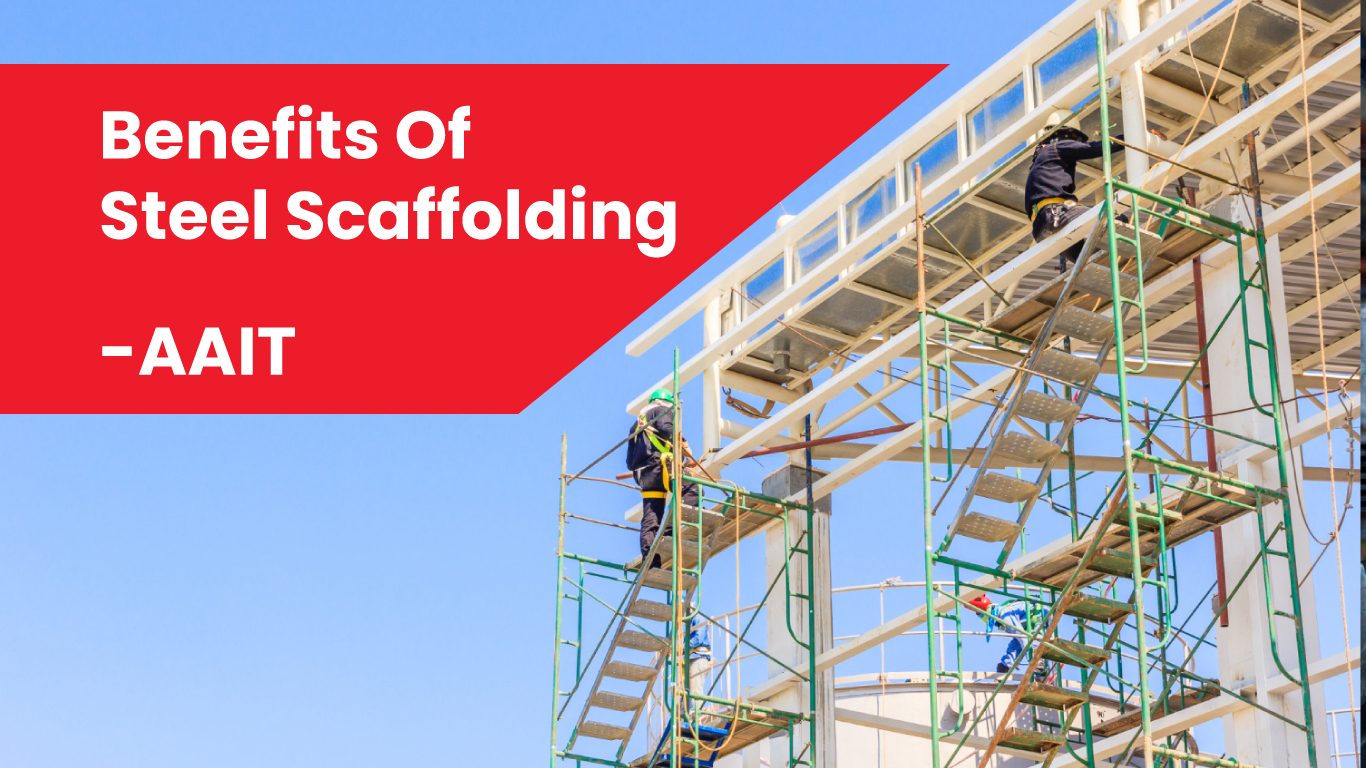
What is Steel Scaffolding
Safety, as well as efficiency, is at the forefront of the construction world. One of the most vital systems that promote safety and efficiency is scaffolding. While there are numerous different systems to select from today, steel scaffolding has become the preferred system due to its strength, safety, and versatility. Steel scaffolding is recognized as a stable and durable system and is predominantly found on large-scale construction job sites, particularly high-rise developments and complex building projects.
Benefits of Steel Scaffolding
Steel scaffolding has a high load capacity of up to 800 KN
The greatest advantage of steel scaffolding is its load-bearing strength, as it can safely handle weights ranging up to 800 kilonewtons. This ability to handle significant loads means that steel scaffolding can accommodate several pieces of heavy equipment, building materials, and large groups of workers. This kind of performance is ideal for demanding projects where safety and stability cannot be compromised.
Durable with up to 50 years of an extended lifespan
Steel scaffolding is built to last, and if it is cared for, it can last for decades. With responsible use, it can be used safely for upwards of 50 years. This makes it a logical long-term investment for construction firms and contractors that often need scaffolding systems.
Cheaper than aluminum scaffolding
While aluminum scaffolding is lighter, steel scaffolding wins when it comes to affordability. It is more budget-friendly in terms of material costs, especially for larger-scale or permanent construction projects where a higher volume of scaffolding is required.
Prefabricated Sizes and Lengths
General steel scaffolding components are manufactured to prefabricated standards. Assembly time is quicker and more predictable when we use prefabricated sizes, reducing the amount of cutting and adjusting on-site, which also saves time and labor.
Easy Erection and Dismantling
While the components are surprisingly robust, steel scaffolding is intended to be assembled and disassembled quickly. The components can be easily connected and do not require heavy machinery or heavy lifting to set them up. This completely minimizes setup time and allows the project to progress faster.
48.3 mm Standard Diameters
Most steel scaffolding systems are constructed using tubes that are manufactured to a standard 48.3 mm diameter. This ensures that all parts and accessories can be used interchangeably when a work crew arrives on site. If everyone adheres to this standard, erecting the system will not incur any costs, as the likelihood of incorrect fittings on-site is minimal.
Complete Standards, Regulations, Assembly Guides
Steel scaffolding is backed by a wide range of industry standards and safety guidelines. These incorporate load ratings, material specifications, and assemblages, making sure that every setting is categorized with thoughtful safety conditions and adhered to requirements.
Steel Scaffolding Has a Wide Application
Steel scaffolding can be used for too many jobs, from residential housing to bridges to industrial sites. Its versatility makes it the embodiment of construction adaptability. Steel scaffolding can be used to get jobs done, like painting, bricklaying, or completing exterior cladding.
Steel Scaffolding Has Designed Safety Protection Elements
Steel scaffolding constructed with guardrails, base plates, and toe boards. It is designed to prevent falls, slips, and structural collapses, becoming an essential protective measure designed to protect the workers and the public.
Steel scaffolding is non-combustible
Unlike wood or some of the plastic-based systems, the advantage of steel is that steel does not burn. Steel can add another layer of safety to protection in situations where fire is a concern from welding or other hot work.
Easy for Access
Scaffolding should not be about support alone but should also include accessibility. Steel is constructed to offer easy access to reach heights safely for the worker’s use. The platforms will be stable and the handrails will allow for easy movement as well as safety.
Great For High-Rise Construction
When it comes to tall buildings and skyscrapers, steel scaffolding stands out. Its load-bearing strength, stability, and wind resistance make it a go-to choice for vertical projects. Even at great heights, it offers a secure working platform.
Height Adjustable
Height flexibility is essential in dynamic construction zones. Steel scaffolding systems are modular and height adjustable, allowing them to be tailored to specific project requirements as the work progresses upward.
Steel Scaffolding Suit For Large Construction Projects
Large-scale projects often require equipment that is tough, scalable, and reliable. Steel scaffolding meets all these criteria. It can support massive structures and complex designs with ease, making it a preferred solution for commercial developments.
Environmentally Friendly
While steel production does use energy, steel scaffolding is highly reusable and recyclable. Many contractors reuse the same scaffolding for multiple projects, and at the end of its lifespan, the metal can be recycled, reducing environmental impact.
Disadvantages of Steel Scaffolding
Like any material, steel scaffolding does have its downsides. One of the main concerns is weight. Steel is heavier than aluminum or timber, which can make transportation and manual handling a bit more challenging. It may also be prone to rusting if not properly maintained, especially in humid or coastal environments. Regular inspection and protective coatings like galvanization can help manage this issue. Lastly, while it’s cost-effective in the long run, the initial investment may be higher compared to simpler scaffolding types.
What are the Different Types of Steel Scaffolding in Construction?
Construction sites may use various steel scaffolding types depending on the nature of the project. Common styles include:
- Tube and coupler scaffolding: Offers high flexibility and can be built to custom shapes.
- System scaffolding (modular): Pre-engineered systems with easy locking features.
- Cantilever scaffolding: Used when the ground is unsuitable for base support.
- Suspended scaffolding: Hangs from rooftops and is ideal for window cleaning or façade painting.
Each type is designed to meet specific project demands and site constraints.
What are the Different Types of Steel Scaffolding Material?
Modular Steel Scaffolding
This type comes with pre-engineered connections and is perfect for quick assembly. It is widely used in high-rise and industrial construction for its structural efficiency.
Steel Tube and Clamps
An older but reliable method where steel tubes are connected using adjustable clamps. It’s versatile and can be used in almost any shape or layout.
Adjustable Props
These are vertical steel props used for shoring and supporting formwork. They can be adjusted in height and are often used in building interiors.
Frame Scaffolding
Frame scaffolding is a common system where the structure is made from welded steel frames. It is easy to set up and often used for simpler projects and maintenance work.
Steel boards and Steel Stairs
Steel plank platforms provide safe and slip-resistant walking surfaces. Steel stair stringers offer solid access between levels, especially in taller scaffold systems.
Steel Scaffolding Grades
Steel scaffolding materials are available in various grades depending on strength and durability. Common grades include mild steel, carbon steel, and high-tensile steel. The choice of grade affects the scaffold’s ability to withstand loads, environmental factors, and corrosion resistance. Contractors select scaffolding grades based on engineering requirements and site conditions.
Steel Scaffolding Sizes
Standard sizing ensures compatibility and safety. Vertical and horizontal tubes generally come in 48.3mm diameter, while the length can vary from 0.5 to 6 meters. Different configurations can be created by combining multiple sizes.
Steel Plank Sizes
Steel planks used for working platforms are available in widths of around 225mm and lengths ranging from 1 to 3 meters. These planks often have perforations for grip and drainage.
Steel Scaffold Parts & Components Plus The Function
A typical steel scaffolding setup includes the following components:
- Standards: Vertical tubes that carry the load to the ground
- Ledgers: Horizontal supports that connect standards
- Transoms: Cross pieces to support planks and bear weight
- Base plates: Spread the load at the bottom
- Couplers: Join tubes together
- Guardrails and toe boards: Improve safety on platforms
- Stair stringers and ladders: Help with vertical movement
Each part has a role in ensuring structural balance and worker safety.
What are the alternatives to steel scaffolding?
Steel Scaffolding vs. Timber Scaffolding
Timber scaffolding is often cheaper and lighter but lacks the strength and longevity of steel. It is more prone to weather damage and requires more frequent replacement.
Steel Scaffolding vs. Aluminum Scaffolding
Aluminum scaffolding is lighter and easier to carry but cannot support as much weight. Steel Scaffolding is stronger, more stable, and better suited for long-term or heavy-duty projects.
Steel Scaffolding Lifespan
With good care, steel scaffolding can last for up to 50 years. Regular inspection, proper storage, and rust prevention methods like galvanizing help extend its lifespan. The reusable nature of steel makes it both economical and sustainable over the long term.
Steel Scaffolding Erection Steps
Setting up steel scaffolding involves the following steps:
- Prepare the ground with base plates and sole boards
- Install vertical standards and secure them
- Add ledgers and transoms for structural framework
- Fix platforms using steel planks
- Attach guardrails and toe boards for safety
- Add access points such as ladders or steel stair stringers
- Inspect the entire structure for stability and safety compliance
Proper training and safety gear are essential throughout the process.
Conclusion
Steel scaffolding is a trusted system in the construction industry, known for its strength, longevity, and versatility. With the right materials and proper handling, it provides a safe and efficient way to work at height. Whether it’s a residential build or a massive commercial project, steel scaffolding proves to be a smart investment for contractors aiming for quality, safety, and cost-effectiveness.












 Download
Download
Comments are closed